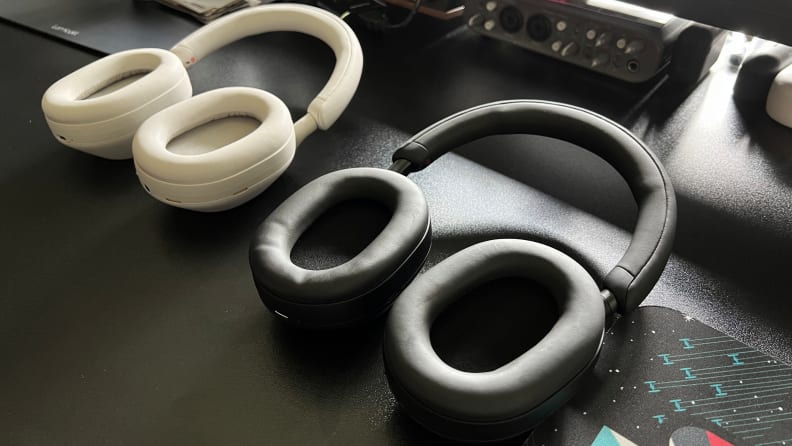
These days, noise-canceling is almost a headphone necessity. Active Noise Canceling (ANC) headphones can’t eliminate all the noise around you. However, they can drastically reduce the worst of it, from managing crowd murmur to canceling out airplane noise. Add a little music into the equation and you’ve got some much-needed peace and quiet.
After testing dozens of headphones in our labs and in the real world, we’re confident the Sony WH-1000XM5
(available at Amazon for $348.00)
are the best noise-canceling headphones available. They combine top-tier noise crushing with phenomenal features, comfort, and sound quality.
But there are plenty of great options, from over-ear models to noise-canceling earbuds, so you can find the perfect pair for you.

Credit:
Reviewed/Ryan Waniata

The Sony WH-1000XM5 are premium noise canceling masters.

Credit:
Reviewed / John Higgins

Not only do the Sony WF-1000XM5 deliver the best noise-canceling performance, they sound excellent, too.

Credit:
Reviewed / Ryan Waniata

The Apple AirPods Pro (2nd generation) deliver significant upgrades to noise canceling, transparency mode, and sound.

Credit:
Reviewed / John Higgins

The Anker Soundcore Space A40 earbuds deliver the best ANC performance you can get for under $100.
Other Noise-Canceling Headphones We Tested
How We Test Noise-Canceling Headphones
The Testers
John Higgins is Reviewed’s Managing Editor for Tech. Before Reviewed, John covered all manner of electronics including TVs, projectors, AVRs, speakers, monitors, and computer peripherals for ProjectorCentral, IGN, Sound & Vision, T3, and Home Theater Magazine, among others. He also spent time as a sound editor and re-recording mixer for films, was a music teacher and music director at a private school in Los Angeles for 10 years, and recorded albums and played shows with a rock band.
Other testers who contributed to this guide include Reviewed’s former Managing Editor Ryan Waniata, former A/V Editor Lee Neikirk, Reviewed Contributor Nick Woodard, Reviewed Contributor Nicole Carpenter, and Reviewed’s former Director of Content Production TJ Donegan.
The Tests
While we focus here on noise cancelation, we ultimately cover every angle on each headphone set we test with a mix of real-world and lab testing. That includes data collection and A/B testing on factors like max volume, active noise cancellation, and more.
For every set of headphones, we use a wide variety of test tracks, ranging from classical to hip-hop, rock, jazz, and more. We A/B test noise cancellation performance against our top picks using simulated sounds like airplane drone, crowd chatter, and pink noise. The tests feed into a scoring system designed to get us as close as possible to an objective overall ranking.
In addition to noise cancelation, we want to make sure the headphones we recommend excel at the other factors that make headphones worth buying. We test for key factors like battery life, ease of use, controls, wireless range, comfort, and more to determine overall performance.
We also go beyond the lab to test every feature we can in real-life situations. We measure sweat-proofing, short- and long-term comfort, battery life, microphone quality, and connectivity over distances and through obstacles like doors and walls.
And while the testing cycle makes it impossible to measure how a set of headphones holds up over the long haul, we do what we can to compensate. While we don’t factor them into our scores, we look to customer reviews to see if we need to make any notes about how a set may hold up.
We also keep using these headphones over time. If firmware updates add new features, or if we find they hold up exceptionally well (or poorly), we update our reviews and rankings with that information.
In-Ear vs. On-Ear vs. Over-ear Headphones

Credit:
Reviewed
Three popular types of headphones: in-ear, on-ear, and over-ear.
Generally speaking, there are three major types of headphone: in-ear, on-ear, and over-ear. On-ear headphones, with cups that sit atop your ears, are becoming far less common. Over-ear headphones use large cups that envelop your ears, helping insulate you from outside noise. In-ear headphones, more commonly called earbuds, nestle into place within your ear itself.
Active Noise Cancellation vs. Passive Noise Cancellation
Active Noise Cancellation (ANC) minimizes external sound by using small microphones to analyze incoming frequencies and then flipping their polarity to “cancel” them out. On the other hand, Passive Noise Cancellation (also referred to as passive noise isolation), uses materials and design to physically muffle or block outside sound. A strong mix of both is generally preferred to create the most effective noise cancellation.
Noise Cancellation and Sound Quality
Because active noise cancellation may introduce additional sound when engaged, it can affect the sound quality of what you’re listening to. Thankfully, this is becoming less of an issue among newer models.
Most noise cancellation headphones let you turn ANC on or off. More advanced models even allow for different levels of cancellation or feature Adaptive Active Noise Cancellation that automatically adjusts for the scenario and environment.
Does Noise Cancellation Block All Noise?
Noise cancellation is best at low, steady sounds like airplane engine drones. Even higher, steady sounds like air conditioning hums get dispatched fairly easily. The biggest test of noise cancellation comes with variable, midrange sounds like nearby conversations.
Since that’s the most distracting kind of sound for many people, shelling out for top-tier noise cancellation can be a big benefit when it comes to focusing on work in a crowded space.
Noise Cancellation
More Articles You Might Enjoy
 Print
Print






